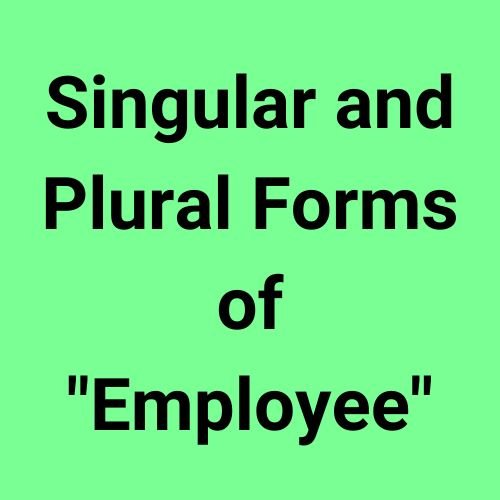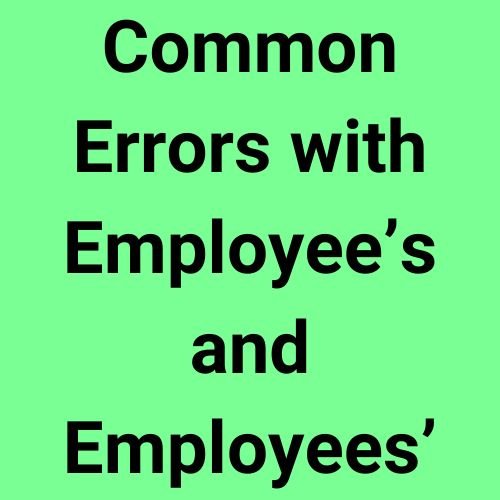When it comes to understanding the difference between employee’s and employees’, the placement of the apostrophe might seem like a minor detail, but it can significantly alter the meaning of your sentence. This article will delve into the plural and possessive forms of the word “employee,” providing clarity and practical examples to help you master its usage. Whether you’re crafting professional emails or drafting official reports, understanding these grammar rules ensures your communication remains precise and effective.
Table of Contents
ToggleWhat Do Employee’s and Employees’ Mean?

The confusion between employee’s and employees’ arises from the rules of grammar concerning singular and plural possessive nouns. Let’s break it down:
- Employee’s: Refers to something that belongs to one employee. It is the singular possessive form of “employee.”
Example: The employee’s laptop is on the desk. - Employees’: Refers to something that belongs to multiple employees. It is the plural possessive form of “employees.”
Example: The employees’ lounge was recently renovated.
Singular and Plural Forms of “Employee”

To grasp the possessive forms, it’s essential first to understand the singular and plural forms of the word “employee.”
Singular Form
“Employee” refers to an individual who works for an organization or employer.
Example: The employee submitted her timesheet.
Plural Form
The plural form of “employee” is employees, representing more than one person.
Example: The company hired ten new employees last month.
How to Form Possessive Nouns
The rules for creating possessive nouns depend on whether the noun is singular or plural:
- For singular nouns, add an apostrophe followed by “s” (‘s).
Example: The employee’s badge was left in the office. - For plural nouns ending in “s”, simply add an apostrophe after the “s”.
Example: The employees’ shifts were adjusted during the holidays. - For plural nouns not ending in “s”, add an apostrophe followed by “s” (‘s).
Example: The children’s play area is next to the cafeteria.
Common Errors with Employee’s and Employees’

Even seasoned professionals sometimes misuse employee’s and employees’. Here are examples of common errors and how to avoid them:
- Incorrect: The employee’s schedules were updated.
Correct: The employees’ schedules were updated. (Refers to schedules of multiple employees.) - Incorrect: All employees meeting was canceled.
Correct: All employees’ meeting was canceled. (Indicates ownership by all employees.)
Employee’s or Employees’: Practical Usage Examples
Let’s explore the correct usage of employee’s and employees’ in various contexts:
| Form | Example | Explanation |
|---|---|---|
| Employee’s (singular) | The employee’s performance was outstanding. | Refers to the performance of one employee. |
| Employees’ (plural) | The employees’ feedback was collected during the meeting. | Refers to feedback from all employees. |
| Singular noun | The employee attended the training session. | Refers to a single employee. |
| Plural noun | Several employees expressed their concerns about the new policy. | Refers to multiple employees. |
Determiners and “Employee”
Determiners can enhance the clarity of your sentence when paired with “employee” or “employees.” Here are some examples:
- The: The employee completed the task.
- All: All employees must adhere to the new guidelines.
- My: My employee’s contribution was invaluable.
- Those: Those employees deserve recognition for their hard work.
Using “All” with Employees
The word all is frequently used with plural nouns like “employees.” Here’s how it works:
- Correct: All employees were invited to the conference.
- Incorrect: All employee were invited to the conference.
In rare cases, “all” can describe a singular form when used attributively (e.g., employee benefits).
FAQs About Employee’s or Employees’
1. What is the difference between employee’s and employees’?
Employee’s refers to something belonging to one employee, while employees’ refers to something belonging to multiple employees.
2. When should I use employee’s?
Use employee’s when discussing something owned by one employee, such as The employee’s ID badge was misplaced.
3. Is employees the same as employees’?
No. Employees is the plural form, meaning multiple employees, while employees’ is the plural possessive form, showing ownership by those employees.
4. How do you pluralize “employee”?
The plural of “employee” is employees, formed by adding an “s.”
5. Can “employee’s” be used in formal writing?
Yes, employee’s is appropriate for formal writing when correctly showing possession for a singular employee.
6. What is an example of employees’ in a sentence?
The employees’ rights were protected under the new policy.
7. Does employees’ always refer to ownership?
Yes, employees’ implies ownership or possession by multiple employees.
8. What does “all employees” mean?
It means every employee within a group or organization. Example: All employees must follow safety procedures.
Key Points to Remember
- Employee’s is singular possessive, while employees’ is plural possessive.
- The position of the apostrophe determines whether you refer to one employee or multiple employees.
- Pair determiners with “employee” or “employees” to add context and specificity.
- Always match the plural or possessive form with the intended meaning in your writing.
Conclusion
Mastering the difference between employee’s and employees’ is crucial for clear and professional communication. By understanding the rules of singular and plural possessive nouns, you can ensure your writing remains grammatically correct and precise. Next time you’re drafting a sentence, remember these simple guidelines to confidently use employee’s or employees’ in the right context.

